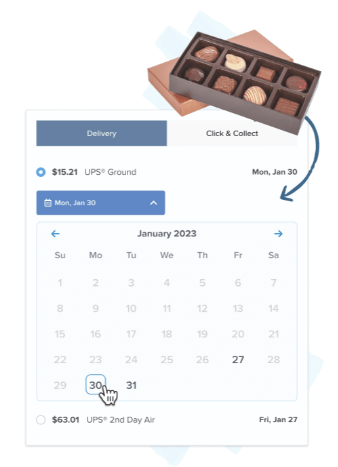Buy Online, Pickup In-Store (BOPIS) is the third most-used fulfillment method among online shoppers.
In today’s eCommerce world, convenience is king. Customers expect options that seamlessly fit into their busy lives, from same-day shipping to transparent delivery timelines. While doorstep delivery is popular, store pickup has quickly emerged as a favorite for both merchants and customers.
If your business hasn’t embraced store pickup, you might be missing a significant opportunity. When done right, it boosts customer satisfaction, streamlines operations, and increases sales. Done poorly? It can lead to frustrated customers, lost revenue, and a tarnished brand reputation.
In this blog, we’ll explore five common mistakes retailers make when offering store pickup—and provide actionable tips to fix them.
Why Store Pickup Matters in eCommerce
The store pickup option offers:
- Convenience: Customers can avoid delivery fees and schedule pickups at their convenience.
- Speed: Many stores offer same-day or next-day pickup options, a faster alternative to standard shipping.
- Flexibility: Customers can shop online but still enjoy the in-store experience.
Avoiding common pitfalls in your store pickup process can make all the difference in ensuring a seamless, satisfying customer journey. Let’s dive into the top mistakes and how to avoid them.
1. Unclear Communication of the Pickup Process
The Problem:
Imagine ordering an item online and arriving at the store only to find no clear instructions. Should you go to customer service? Call a number? Wait somewhere? Confusion like this frustrates customers and creates operational bottlenecks.
How to Avoid It:
- Outline the process upfront:
Use email confirmations, SMS notifications, and your website to explain pickup steps. - Set clear expectations:
Provide details like:- Pickup hours.
- Required documentation or identity proof.
- Exact pickup location.
- Use multiple touchpoints:
Reinforce instructions at checkout, in confirmation emails, and through reminder notifications. - In-store signage:
Clearly label the pickup area with directional arrows and signs like “Order Pickup” or “Click-and-Collect.”
When customers feel confident and informed, they’ll have a smoother experience and fewer errors or delays.
2. Limited Pickup Time Windows
The Problem:
Restricting pickups to narrow timeframes can alienate customers and lead to missed pickups. This creates operational headaches and storage issues.
How to Avoid It:
- Extend pickup hours:
Align them with your store’s operating hours or assign staff for after-hours pickups. - Offer flexible scheduling:
Let customers choose and modify their preferred pickup times. - Consider curbside pickup:
Provide a quick, contactless option for added convenience.
Flexible pickup options enhance customer satisfaction and keep your service competitive.
3. Inefficient Order Management Systems
The Problem:
An inefficient order management system (OMS) leads to misplaced orders, long wait times, and frustrated employees. Manual processes or outdated technology often cause bottlenecks.
How to Avoid It:
- Invest in automation:
Use an OMS that integrates with your eCommerce platform and tracks the full order lifecycle. - Streamline in-store workflows:
Train staff to manage pickups efficiently, from retrieving items quickly to verifying customer details without delays. - Provide real-time updates:
Notify customers when their order is ready or if there’s an unexpected delay.
Efficient systems reduce errors and enhance the pickup experience for customers and employees.
4. Neglecting the Pickup Area
The Problem:
A cluttered, poorly marked pickup area frustrates customers. Wandering around unsure of where to go or waiting in long queues creates a negative experience.
How to Avoid It:
- Designate a specific area:
Set up a clear, easily accessible pickup zone inside the store or outside for curbside services. - Keep it organized:
Ensure the area is tidy, stocked with necessary tools (scanners, bags, etc.), and staffed by trained employees. - Brand the space:
Use branded signage and decor to create a welcoming, professional look.
A well-maintained pickup area shows customers you value their time and experience.
5. Ignoring Customer Feedback
The Problem:
Without customer feedback, you may not realize there are issues in your store pickup process. You might think everything is running smoothly, but customers could have a different perspective.
How to Avoid It:
- Request feedback:
Send follow-up surveys via email or SMS to gather insights on their pickup experience. - Act on insights:
Address recurring issues and continuously improve your process. - Analyze trends:
Use analytics to spot patterns in customer behavior and feedback. For instance, frequent rescheduling may indicate a need for more flexible time slots.
Listening to your customers fosters loyalty and helps you identify areas of improvement.
Why Getting Store Pickup Right Matters
Avoiding these pitfalls is crucial, but having the right tools makes all the difference. The key is to prioritize clarity, flexibility, and efficiency in every aspect of the process.
While implementing these strategies might seem daunting, the right tools can simplify the process. ShipperHQ lets you offer customers the flexibility and convenience they crave with in-store pickup options and a simple, interactive calendar date selector in the checkout. In addition, you can also show customers the exact pickup locations via Google Maps at checkout with store hours and contact information.
Start your 15-day free trial with ShipperHQ today and transform the way you manage store pickup.
FAQs
- What are the most common mistakes businesses make with store pickup?
Poor communication, limited flexibility, inefficient systems, disorganized pickup areas, and ignoring customer feedback.
- How can I improve the efficiency of my store pickup process?
Invest in automation, streamline communication, and create a designated pickup zone.
- What are the best practices for setting up an in-store pickup area?
Clear signage, organized spaces, and trained staff are key.
- How do I collect and act on feedback about my store pickup service?
Use surveys, analyze data, and continuously refine your process.







